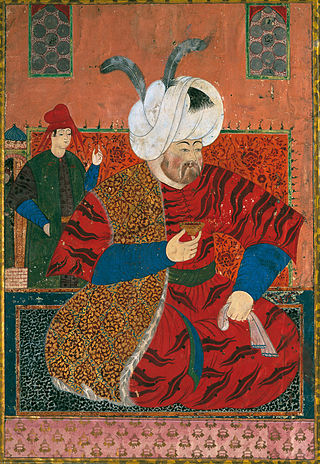
Selim II, also known as Selim the Blond or Selim the Drunk, was the Sultan of the Ottoman Empire from 1566 until his death in 1574. He was a son of Suleiman the Magnificent and his wife Hurrem Sultan. Selim had been an unlikely candidate for the throne until his brother Mehmed died of smallpox, his half-brother Mustafa was strangled to death by the order of his father, his brother Cihangir succumbed to chronic health issues, and his brother Bayezid was killed on the order of his father after a rebellion against Selim. Selim died on 15 December 1574 and was buried in Hagia Sophia.
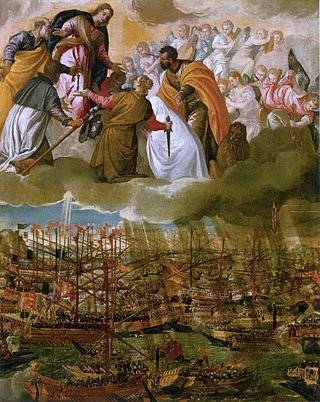
The Battle of Lepanto was a naval engagement that took place on 7 October 1571 when a fleet of the Holy League, a coalition of Catholic states arranged by Pope Pius V, inflicted a major defeat on the fleet of the Ottoman Empire in the Gulf of Patras. The Ottoman forces were sailing westward from their naval station in Lepanto when they met the fleet of the Holy League which was sailing east from Messina, Sicily. The Spanish Empire and the Venetian Republic were the main powers of the coalition, as the league was largely financed by Philip II of Spain, and Venice was the main contributor of ships.
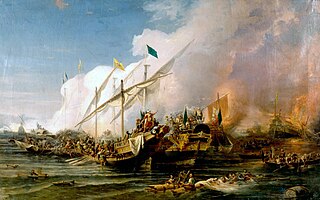
The Battle of Preveza was a naval battle that took place on 28 September 1538 near Preveza in Ionian Sea in northwestern Greece between an Ottoman fleet and that of a Holy League assembled by Pope Paul III. It occurred in the same area in the Ionian Sea as the Battle of Actium, 31 BC. It was one of the three largest sea battles that took place in the sixteenth century Mediterranean, along with the Battle of Djerba and the Battle of Lepanto. In this battle, the Ottomans defeated the Europeans.
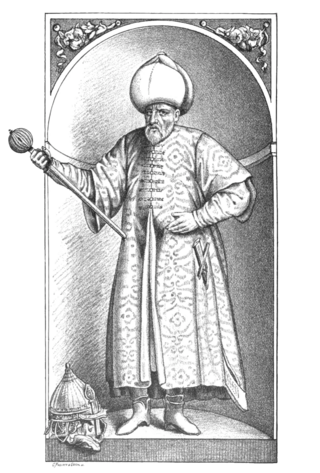
Sokollu Mehmed Pasha was an Ottoman statesman most notable for being the Grand Vizier of the Ottoman Empire. Born in Ottoman Herzegovina into an Orthodox Christian Serbian family, Mehmed joined consensually to serve as a janissary to the Ottoman devşirme system of recruiting Christian boys to be raised as officers or administrators for the state. He rose through the ranks of the Ottoman imperial system, eventually holding positions as commander of the imperial guard (1543–1546), High Admiral of the Fleet (1546–1551), Governor-General of Rumelia (1551–1555), Third Vizier (1555–1561), Second Vizier (1561–1565), and as Grand Vizier under three sultans: Suleiman the Magnificent, Selim II, and Murad III. He was assassinated in 1579, ending his near 15-years of service to several Sultans, as sole legal representative in the administration of state affairs.

Occhiali was an Italian farmer, then Ottoman privateer and admiral, who later became beylerbey of the Regency of Algiers, and finally Grand Admiral of the Ottoman fleet in the 16th century.
This is the order of battle during the Battle of Lepanto on 7 October 1571 in which the Holy League deployed 6 galleasses and 206 galleys, while the Ottoman forces numbered 216 galleys and 56 galliots.

Marcantonio II Colonna, Duke of Tagliacozzo and Duke and Prince of Paliano, was a Roman aristocrat who served as a Viceroy of Sicily in the service of the Spanish Crown, Spanish general, and Captain General of the Church. He is best remembered for his part as the admiral of the Papal fleet in the Battle of Lepanto.

Hayreddin Barbarossa, also known as Hayreddin Pasha, Hızır Hayrettin Pasha, and simply Hızır Reis, was an Ottoman corsair and later admiral of the Ottoman Navy. Barbarossa's naval victories secured Ottoman dominance over the Mediterranean during the mid-16th century.

Piali Pasha, was an Ottoman Grand Admiral between 1553 and 1567, and a Vizier (minister) after 1568. He is also known as Piale Pasha in English.

The Ottoman Navy, also known as the Ottoman Fleet, was the naval warfare arm of the Ottoman Empire. It was established after the Ottomans first reached the sea in 1323 by capturing Karamürsel, the site of the first Ottoman naval shipyard and the nucleus of the future Navy.

Real was a Spanish galley and the flagship of Don John of Austria in the Battle of Lepanto in 1571.

Lala Mustafa Pasha, also known by the additional epithet Kara, was an Ottoman Bosnian general and Grand Vizier from the Sanjak of Bosnia.
Salah Rais was the 7th King of Algiers, an Ottoman privateer and admiral. He is alternatively referred to as Sala Reis, Salih Rais, Salek Rais and Cale Arraez in several European sources, particularly in Spain, France and Italy.

The Ottoman-Portuguese conflicts were a period of conflict during the Ottoman–Portuguese confrontations and series of armed military encounters between the Portuguese Empire and the Ottoman Empire along with regional allies in and along the Indian Ocean, Persian Gulf, and Red Sea.

The Fourth Ottoman–Venetian War, also known as the War of Cyprus was fought between 1570 and 1573. It was waged between the Ottoman Empire and the Republic of Venice, the latter joined by the Holy League, a coalition of Christian states formed under the auspices of the Pope, which included Spain, the Republic of Genoa, the Duchy of Savoy, the Knights Hospitaller, the Grand Duchy of Tuscany, and other Italian states.
John VIII served as an archbishop of Antivari in the mid-16th century.
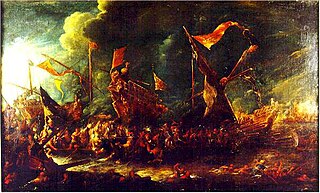
The Battle of Cape Corvo was a naval engagement of the Ottoman–Habsburg wars fought as part of the struggle for the control of the Mediterranean. It took place in August 1613 near the island of Samos when a Spanish squadron from Sicily, under Admiral Ottavio d'Aragona, engaged an Ottoman fleet led by Sinari Pasha. The Spanish were victorious and captured seven galleys and about 600 prisoners, among them the Bey of Alexandria and another 60 important Ottoman nobles. Cape Corvo was the first major victory of the Spanish fleets under Pedro Téllez-Girón, 3rd Duke of Osuna, the Spanish Viceroy of Sicily, as well as the greatest Spanish victory over the Ottoman Empire since the Battle of Lepanto.
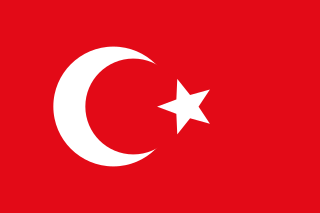
The Eyalet of the Archipelago was a first-level province (eyalet) of the Ottoman Empire. From its inception until the Tanzimat reforms of the mid-19th century, it was under the personal control of the Kapudan Pasha, the commander-in-chief of the Ottoman Navy.

The Imperial Arsenal was the main base and naval shipyard of the Ottoman Empire from the 16th century to the end of the Empire. It was located on the Golden Horn in the Ottoman capital, Constantinople.

The siege of Famagusta happened in Venetian-controlled Famagusta, the last Christian possession in Cyprus. Famagusta fell to the Ottomans in August 1571 after a siege that lasted nearly a year.

















